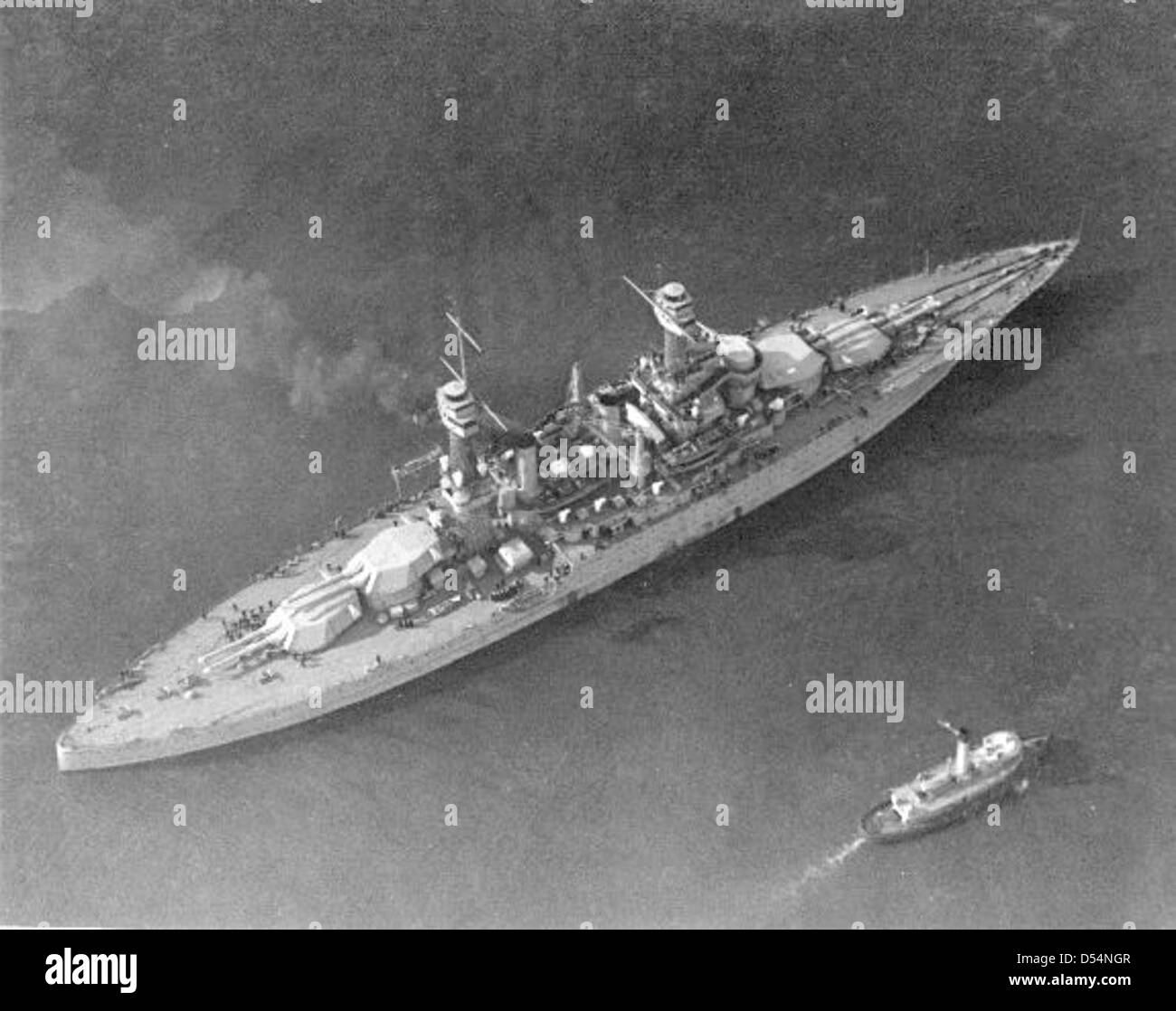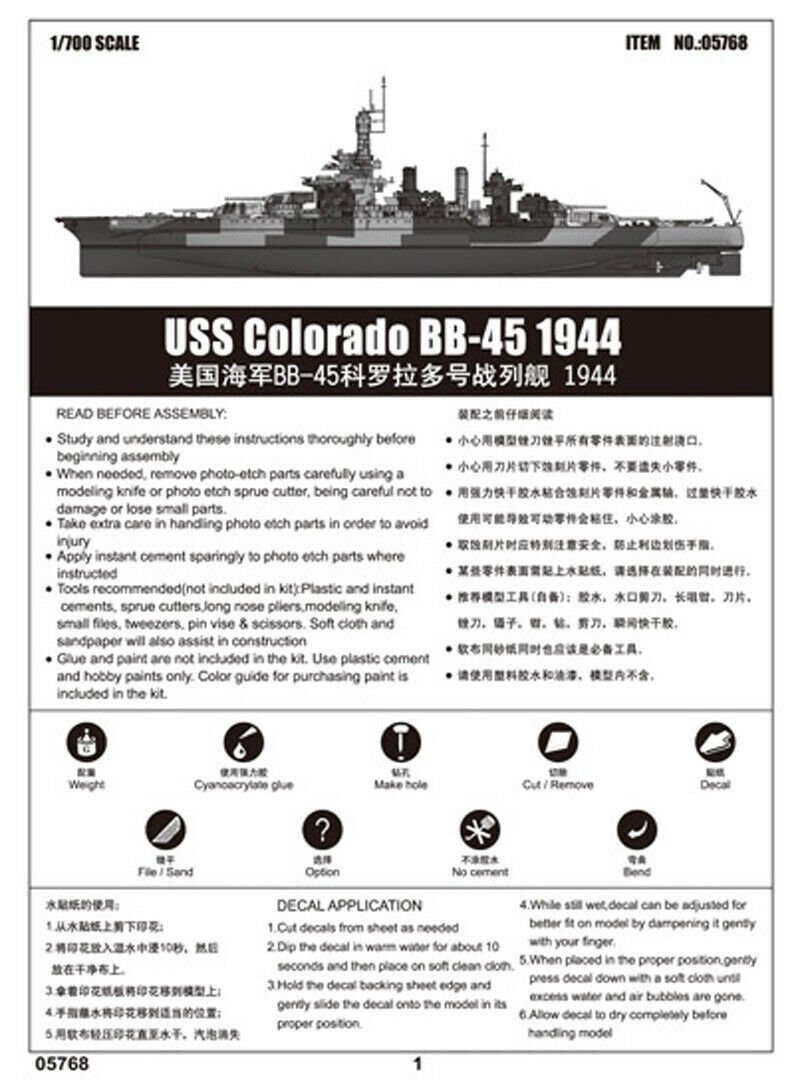Uss Colorado Battleship - USS Colorado (BB-45) was a United States Navy battleship in service from 1923 to 1947. She was the flagship of the Colorado class of battleships. Her hull was scuttled on May 29, 1919 by the New York Shipbuilding Company. He was launched on March 22, 1921 and commissioned on August 30, 1923. Two 5-inch guns were removed in the overhaul.
In 1923 Colorado took her cruise to Europe. He later served in the Battle Fleet and sailed across the Pacific during the interwar years. She also underwent another upgrade when her four 3-inch (76 mm) anti-aircraft guns were replaced by an equal number of 5-inch (127 mm)/25 cal.
Uss Colorado Battleship

During World War II, in May 1942, shortly after the United States entered the war, Colorado undertook a defensive patrol near the Golden Gate Bridge to stop a Japanese attack. He went to Fiji to stop the Japanese advance into the Pacific. He then supported the invasions of Tarawa, the Marshall Islands, Saipan, Guam, and Tinian. On 24 July 1944, during the raid on Tinian, Colorado received 22 rounds from shore batteries, but continued to support the attacking forces until 3 August. She again arrived in Leyte Gulf on 20 November 1944 to support American forces fighting ashore. She was hit by two kamikaze on 27 November, causing moderate damage.
Lego® Uss Colorado (bb 45) Battleship Moc
Colorado then proceeded to Luzon on 1 January 1945, where she participated in the pre-invasion bombardment of Lingay Gulf. He returned to Okinawa on August 6, and from there proceeded to Japan to occupy the country, arriving in Tokyo on August 27. Departing Tokyo Bay on 20 September, she arrived in San Francisco on 15 October. She was decommissioned at Pearl Harbor on 7 January 1947 and sold for scrapping on 23 July 1959. He earned seven battle stars during his service. Many of the Colorado anti-aircraft guns are in museums across the state of Colorado (the bell and its teak deck are also in museums and the USO at Seattle-Tacoma Airport) or are mounted on the Olympia museum boat.
In 1916, design work was completed on the next class of battleships to be built for the US Navy in 1917. These ships were almost exact copies of the earlier Tnessee class, except for the main battery, which was increased from twelve inches to 14 inches. (356 mm) guns to eight 16-inch (406 mm) guns. The Colorado class was the last class of warships to be completed of the conventional type.
Colorado was 624 feet (190 m) long overall and had a beam of 97 feet 6 inches (29.72 m) and a draft of 30 feet 6 inches (9.30 m). She displaced 32,693 long tons (33,218 t) as designed and up to 33,590 long tons (34,130 t) at full load. The ship was powered by four Geral Electric turbo-electric drives with steam supplied by eight Babcock & Wilcox oil boilers. The ship's propulsion system was rated at 28,900 hp (21,600 kW) for a top speed of 21 knots (39 km/h; 24 mph), but in speed trials it was rated at 31,268 hp (23,317 kW), 21 (09 kW) and The speed reached 09 kW. 39.06 kilometers per hour; 24.27 mph). She had a standard range of 8,000 nmi (15,000 km; 9,200 mi) at a speed of 10 kn (19 km/h; 12 mph), but additional fuel space could be used during combat to extend her range to 21,100 nmi (39,100 km). did 24,300 miles) at that speed. The number of his crew was 64 officers and 1241 people.
She was armed with a main battery of eight 16-inch/45-caliber Mark 1 guns in four twin turrets aft.
Uss Colorado 2
Two forwards and two feet in a supershire pair. The secondary battery consisted of six 5-inch (127 mm) / 51-caliber guns mounted individually in mounted bays in the centers of the superstructure. She carried an anti-aircraft battery consisting of eight 3-inch (76 mm) / 50-caliber guns in separate high-angle mounts. As was common for capital ships of the time, she had a 21-inch (533 mm) torpedo tube mounted in the hull below the waterline on each broadside. The Colorado's main armor belt was 8 to 13.5 inches (203 to 343 mm) thick, while the main deck armor was up to 3.5 inches (89 mm) thick. The main battery gun turrets had 18 in (457 mm) thick plates on 13 in (330 mm) barbettes. Her conning tower was 16 inches (406 mm) thick.
Her hull was scuttled on May 29, 1919 by the New York Shipbuilding Company at Camden, New Jersey.
Named the 38th State, she was launched on 22 March 1921 and commissioned on 30 August 1923 for her first sea trials and training. The ship's first commanding officer was Captain Reginald R. Belknap. On December 29, 1923, the Colorado left New York for Portsmouth, England. He later went south to visit Cherbourg and Villefranche-sur-Mer, France. He also stopped in Naples, Italy, and at the British naval base in Gibraltar. He arrived in New York on February 15, 1924. There, the ship underwent further repairs and trials before departing on July 11 for the west coast of the United States. She arrived at San Francisco, California on 15 September, where she joined the battle fleet. He remained a part of this unit until five years later.

During the 1920s and 1930s, Colorado participated in a series of fleet problems, large-scale training exercises held annually. These have occurred in the Pacific Ocean and the Caribbean Sea. During this time, she also participated in several ceremonies and sea surveys with the rest of the fleet. From 8 June to 26 September 1925, the ship participated in a cruise with several other battleships of the fleet visiting Samoa, Australia, and New Zealand.
Trumpeter Scale Models 5768 1/700 Uss Colorado Bb 45 Battleship 1944 [tsm5768]
Colorado underwent major overhauls in 1928–1929, when the four 3-inch (76 mm) anti-aircraft guns were replaced by eight 5-inch (130 mm) / .25 caliber guns.
From March 10 to 11, 1933, the ship went to Long Beach, California to assist in relief efforts after an earthquake.
In the summer of 1937 Colorado served as a training ship for NROTC cadets from the University of Washington and the University of California, Berkeley. He began his studies at the University of Washington in Puget Sound on June 15, and the University of California at San Francisco Bay Area four days later. The ship arrived in Hilo, Hawaii, on June 26, and two days later headed for the roads of Lahaina, where the boys practiced with 5.51-caliber rifles, their mates strapped into hammocks.
Liberty started in Honolulu on July 1, but was stopped the next day so that Colorado could join the search for Amelia Earhart.
Bb 35 Uss Colorado 1944 (trumpeter)
She joined the US Coast Guard cutter Itasca on 7 July. and launched seaplanes to explore the Fox Islands. After the July 9 crossing of the line ceremony, he returned the NROTC students to their schools on the West Coast.
USS Colorado at Tinian, July 24, 1944, with hull damage from 22 shore battery hits
From 27 January 1941, Colorado was stationed at Pearl Harbor conducting intensive training exercises and participating in various war games until she departed Hawaii for the West Coast on 25 June. Surveying the Puget Sound Navy Yard, he was unprepared for the attack on Pearl Harbor on December 7. During the rebuild, which ended on 31 March 1942, two of the original 12 5-inch guns were removed and replaced with an equal number of 5-inch 38-caliber guns.
After resettling in Colorado, he made extensive training moves on the West Coast. On May 31, he and Maryland were patrolling near the Gold Gate Bridge to protect San Francisco from any Japanese attack. Some time later he returned to Pearl Harbor to make his final preparations for action. She operated near the Fiji Islands and New Zealand from 8 November 1942 to 17 September 1943 to prevent any further Japanese expansion in the Pacific. She departed Pearl Harbor on 21 October 1943 to provide pre-attack shelling and fire support for the attack on Tarawa and returned to port on 7 December 1943. , on January 21, 1944 and settled in the Marshall Islands the next day. She conducted pre-attack bombardment and fire support for the attacks on Kwajalein and Iotok until 23 February, when she proceeded to Puget Sound Naval Yard for further overhaul.
The Battleship That Wasn't There: Uss Colorado
She joined other units bound for the Mariana Islands in San Francisco Harbor. She departed Pearl Harbor and Kwajalein on 5 May for a pre-invasion shell at Saipan, Guam, and Tinian after 14 June. When Tinian was shelled on 24 July, she was hit by 22 shells from Japanese 150mm shore batteries, killing 43 and wounding 198. He continued to shell the island and provide fire support to the attacking forces. After overhauling the west coast, she arrived in the Gulf of Leyte to begin the invasion of Leyte. A week after his arrival, he was hit by two kamikaze bombers
Uss tennessee battleship, uss new jersey battleship, uss arkansas battleship, battleship uss iowa museum, uss missouri lego battleship, uss alabama battleship, uss north carolina battleship, uss battleship museums, uss battleship, battleship uss iowa, uss missouri battleship tour, uss texas battleship
0 Comments